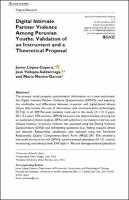Mostrar el registro sencillo del ítem
Digital intimate partner violence among peruvian youths : validation of an instrument and a theoretical proposal
| dc.contributor.author | López Cepero, Javier | |
| dc.contributor.author | Vallejos Saldarriaga, José Francisco | |
| dc.contributor.author | Merino García, María | |
| dc.date.accessioned | 2023-01-18T17:08:38Z | |
| dc.date.available | 2023-01-18T17:08:38Z | |
| dc.date.issued | 2018 | |
| dc.identifier.issn | 1552-6518 | |
| dc.identifier.uri | https://pubmed.ncbi.nlm.nih.gov/30280639/ | |
| dc.identifier.uri | https://hdl.handle.net/20.500.12692/104632 | |
| dc.description.abstract | The present study presents psychometric information on a new instrument, the Digital Intimate Partner Violence Questionnaire (DIPVQ), and explores the similitudes and differences between in-person and digital-based abuses (those that involve the use of information and communication technologies [ICTs]). In all, 449 Peruvian students took part in the study (X = 21.2 years; SD = 4.3 years; 73% women). DIPVQ structure was determined by carrying out an exploratory factor analysis (EFA) with polychoric correlation matrices and oblique rotation. In-person violence was assessed using the Dating Violence Questionnaire (DVQ) and self-labeling questions (e.g., feeling trapped, afraid, and abused). Relationship satisfaction was assessed using the Perceived Relationship Quality Components–Short Form (PRQC-SF). EFA showed a two-scale structure for the DIPVQ: control-centered cyberabuse (N = 5; control, monitoring, and identity theft; EAP alpha = .96) and damage-centered cyberabuse (N = 7; unwanted sexual contents, blackmailing, and causing debts throughout ICT; Expected-A-Posteriori alpha = .97). DIPVQ had direct relationship to DVQ and self-labeling (p < .001; d = 0.38-1.18), and inverse to PRQC-SF (p = .11; d = .22-.33). Behaviors such as impersonation and monitoring were reported by more than 20% of participants. Online and offline victimization coexist in 42% of cases, while 3.6% of aggressions happened exclusively via ICT. DIPVQ is a valid and reliable measure of digital victimization. The controlcentered scale had a higher frequency, although the damage-centered scale had stronger relationship to feeling afraid and abused. While previous literature has classified online aggressions regarding their aesthetic appearance, it seems that their functional value (control vs. hurting) could provide a better framework for understanding these aggressions. | es_PE |
| dc.format | application/pdf | es_PE |
| dc.language.iso | eng | es_PE |
| dc.publisher | Sage Publications | es_PE |
| dc.relation.ispartofseries | Journal of Interpersonal Violence;2021 June ; 36(11-12) | |
| dc.relation.uri | https://pubmed.ncbi.nlm.nih.gov/30280639/ | es_PE |
| dc.rights | info:eu-repo/semantics/openAccess | es_PE |
| dc.rights.uri | https://creativecommons.org/licenses/by/4.0/ | es_PE |
| dc.source | Repositorio Institucional - UCV | es_PE |
| dc.source | Universidad César Vallejo | es_PE |
| dc.subject | Tecnologías de la información y la comunicación | es_PE |
| dc.subject | Redes sociales | es_PE |
| dc.subject | Violencia en el noviazgo | es_PE |
| dc.subject | Violencia de pareja | es_PE |
| dc.title | Digital intimate partner violence among peruvian youths : validation of an instrument and a theoretical proposal | es_PE |
| dc.type | info:eu-repo/semantics/article | es_PE |
| dc.description.sede | Lima Norte | es_PE |
| dc.identifier.doi | 10.1177/0886260518803610 | |
| dc.subject.ocde | https://purl.org/pe-repo/ocde/ford#3.00.00 | es_PE |
| dc.publisher.country | PE | es_PE |
| dc.description.lig | Biodiversidad, cambio climático y calidad ambiental | es_PE |
| dc.description.rsu | Promoción de la salud, nutrición y salud alimentaria | es_PE |
| dc.description.ods | Fin de la pobreza | es_PE |
| dc.relation.isPartOf | urn:issn:1552-6518 | es_PE |
Ficheros en el ítem
Este ítem aparece en la(s) siguiente(s) colección(es)
-
Lima Norte [78]


